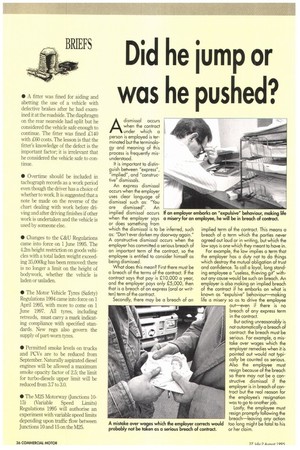• A fitter was fined for aiding and abetting the
Page 38

If you've noticed an error in this article please click here to report it so we can fix it.
use of a vehicle with defective brakes after he had examined it at the roadside. The diaphragm on the rear nearside had split but he considered the vehicle safe enough to continue. The fitter was fined £140 with £60 costs. The lesson is that the fitter's knowledge of the defect is the important factor; it is irrelevant that he considered the vehicle safe to continue.
• Overtime should be included in tachograph records as a work period even though the driver has a choice of whether to work. It is suggested that a note be made on the reverse of the chart dealing with work before driving and after driving finishes if other work is undertaken and the vehicle is used by someone else.
• Changes to the C&U Regulations came into force on 1 June 1995. The 42m height restriction on goods vehicles with a total laden weight exceeding 35,000kg has been removed: there is no longer a limit on the height of bodywork, whether the vehicle is laden or unladen.
• The Motor Vehicle Tyres (Safety) Regulations 1994 came into force on 1 April 1995, with more to come on 1 June 1997. All tyres, including retreads, must carry a mark indicating compliance with specified standards. New regs also govern the supply of part-worn tyres.
• Permitted smoke levels on trucks and PCVs are to be reduced from September. Naturally aspirated diesel engines will be allowed a maximum smoke opacity factor of 2.5; the limit for turbo-diesels upper limit will be reduced from 3.7 to 3.0.
• The M25 Motorway (Junctions 1015) (Variable Speed Limits) Regulations 1995 will authorise an experiment with variable speed limits depending upon traffic flow between Junctions 10 and 15 on the M25.
























































































